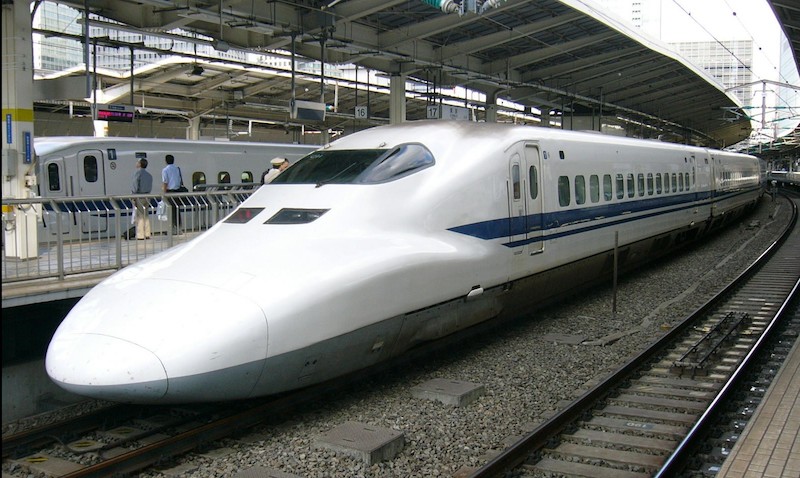
By R. Srinivasan
Mega projects, like mega mountains, shape the environment around them.
“You need vision to think up mega projects, and indomitable will to drive them through. Dubai’s sheikhs have it. They are pumping in north of $82 billion to build the Al Maktoum International Airport, which, when completed next year, will be the world’s largest by a comfortable margin. Could one have imagined that this tiny desert emirate would become a global air travel hub? No. But will it help bring in technologies and services, create tens of thousands of jobs, and probably make Dubai a serious player in the airport-building business (they have already achieved this in seaports)? Yes”, says the author.
So far, the proposed Ahmedabad-Mumbai bullet train project is just a piece of stone that has been laid by Prime Ministers Narendra Modi and Shinzo Abe, but it has already been written off as a white elephant by most analysts and commentators. They are probably right. The project, of course, is alarmingly expensive. And a 0.1% interest on the loan from Japan, despite what the Prime Minister says, is not “practically free of cost”; in fact, it may well be above real interest rates in Japan if you factor in rupee depreciation. Both the fares and the number of passengers have to be unrealistically high if the project is to even come close to breaking even. In fact, with 12 stations on the route, to reach out and touch as many potential voters as possible, it might not even be able to maintain bullet train-levels of average speeds, given the number of starts and stops.
A leap into the unknown
But I am all for bullet trains. Not because I have an economic model which makes the high-speed train project suddenly viable — frankly, it is difficult to counter the logic of the above-mentioned experts — but because there is a dimension to an ambitiously audacious project like this which is being totally missed in the heat and dust kicked up by the whole bullet train debate. It is the transformative impact that such mega projects can have on the entire ecosystem.
Every mega project that we have seen — from China’s Great Wall to the Angkor Wat, from the Taj Mahal to the U.S. Interstate Highway System — has represented a leap into the unknown when it first started. Almost every case has faced the same criticism that the bullet train project is facing now — that it was too unrealistic, too expensive, too fanciful, or just plain megalomaniacal.
But these projects also represent the crowning glories of human achievement. A Taj Mahal is not just one man’s dream; the secret of its enduring appeal is that it is a representation in physical reality of man’s capacity to dream. They also created technologies, processes, and execution capabilities which not only had not existed till then, but had not even been thought of. And in the process, they ended up shaping the world around them forever.
Some of the largest mega projects under way around the world are epitomes of this ability of humans to surpass the possible. Take the International Space Station. It has so far cost nearly $200 billion, but is also our world’s first and only permanent outpost outside it — in space, the jumping-off point for mankind’s eventual spread to the planets and stars beyond. It is also a magnificent example of international collaboration, and a technology generator of mammoth proportions, sparking innovations which are now part of everyday technology.
Vision and will
You need vision to think up mega projects, and indomitable will to drive them through. Dubai’s sheikhs have it. They are pumping in north of $82 billion to build the Al Maktoum International Airport, which, when completed next year, will be the world’s largest by a comfortable margin. Could one have imagined that this tiny desert emirate would become a global air travel hub? No. But will it help bring in technologies and services, create tens of thousands of jobs, and probably make Dubai a serious player in the airport-building business (they have already achieved this in seaports)? Yes.
China’s party leaders have this ability and will as well. The South-North Water Transfer Project is the world’s largest hydro-engineering project, involving, among other things, two mega 1,000-km canals. It costs thrice as much as the mammoth Three Gorges Dam project did, but will solve the water problems of 50% of China’s population in one stroke.
An ability to dream big
We had it too, at one time. In fact, one mega project from the past was, ironically, temporally linked with the bullet train. The Narmada Dam, 56 years after it was started, was dedicated to the nation around the same time the bullet train was announced. Forget all the (again, mostly valid) criticism of the project, the abandonment of dam oustees, and so on, and just look at the project in isolation. Half a century ago, this country had no problems visualizing impossible dreams — damming mighty rivers, building steel plants in the middle of jungles, and so on. We lost that capacity to dream big somewhere along the way, as well as the capacity to execute. Bhakra Nangal got built, but Narmada took half a century. Bhilai and Rourkela got built, but a satisfactory version of the Arjun Main Battle Tank is yet to be inducted, despite having been sanctioned in 1974.
That is why we need more bullet trains. It is not just the one project. Just the technology, engineering and quality levels it brings will alone transform the future of our early industrial age railway system. One showcase team will fire the aspirations of a billion people, just like one Delhi Metro made every city in India try to build one. If we don’t dream big, we will never achieve big.





Be the first to comment